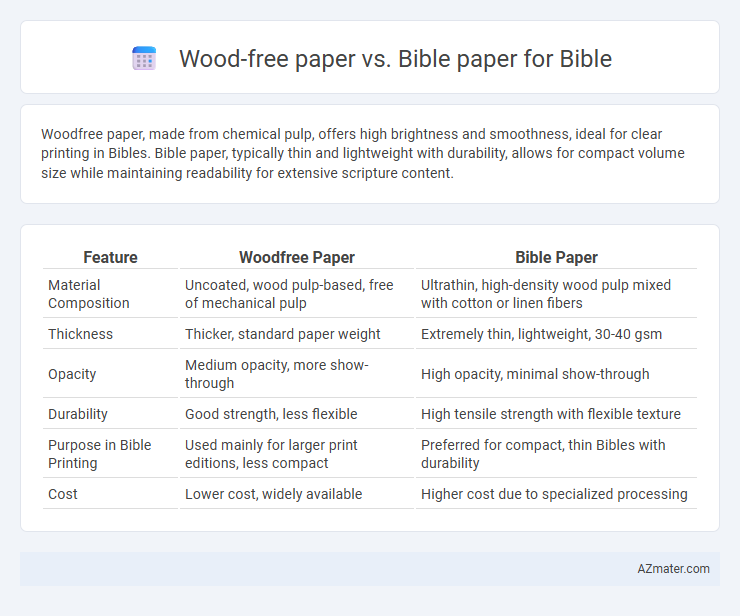Woodfree paper, made from chemical pulp, offers high brightness and smoothness, ideal for clear printing in Bibles. Bible paper, typically thin and lightweight with durability, allows for compact volume size while maintaining readability for extensive scripture content.
Table of Comparison
| Feature | Woodfree Paper | Bible Paper |
|---|---|---|
| Material Composition | Uncoated, wood pulp-based, free of mechanical pulp | Ultrathin, high-density wood pulp mixed with cotton or linen fibers |
| Thickness | Thicker, standard paper weight | Extremely thin, lightweight, 30-40 gsm |
| Opacity | Medium opacity, more show-through | High opacity, minimal show-through |
| Durability | Good strength, less flexible | High tensile strength with flexible texture |
| Purpose in Bible Printing | Used mainly for larger print editions, less compact | Preferred for compact, thin Bibles with durability |
| Cost | Lower cost, widely available | Higher cost due to specialized processing |
Introduction to Bible Paper Types
Bible paper, known for its thin, lightweight, and strong construction, is specifically designed to handle the dense text and frequent use typical in Bibles. Woodfree paper, made from chemically treated wood pulp free of mechanical fibers, offers a smoother surface and higher brightness but tends to be thicker and less flexible than traditional Bible paper. Choosing between woodfree and Bible paper significantly affects readability, durability, and the overall feel of the Bible, with Bible paper preferred for compact editions requiring thin, opaque sheets to minimize bleed-through.
What is Woodfree Paper?
Woodfree paper, commonly used in book printing including Bibles, is made from chemical pulp with minimal lignin content, resulting in smoother, brighter, and more durable pages compared to mechanical pulp papers. This type of paper ensures clarity and longevity, making it ideal for dense text such as Bible scriptures. In contrast, Bible paper, often thinner and lighter, balances durability with reduced bulk for a more portable Bible without sacrificing readability.
What is Bible Paper?
Bible paper is a lightweight, thin, and highly opaque paper designed specifically for printing Bibles and other religious texts, allowing a large number of pages to fit into a compact volume without sacrificing readability. Woodfree paper, while commonly used for printing and writing due to its smooth surface and durability, is thicker and less transparent, making it less suitable for Bibles where page thinness and opacity are critical. The unique properties of Bible paper enable clear, crisp text on ultra-thin pages, balancing durability with the need for portability in religious books.
Physical Properties Comparison
Woodfree paper, typically made from chemical pulp with minimal lignin, offers higher opacity and brightness, resulting in clearer printing and better readability. Bible paper, known for its extreme thinness and lightweight nature, is specially crafted to be strong despite its delicate appearance, allowing a compact Bible design without compromising durability. The density and smoothness of woodfree paper support sharper text, while Bible paper's low-caliper structure optimizes portability and reduces bulk.
Print Quality and Legibility
Woodfree paper offers excellent print quality with smooth surface texture that enhances ink absorption, resulting in sharp and clear text ideal for standard Bibles. Bible paper, typically thinner and more translucent, prioritizes lightweight and compactness but can sometimes suffer from show-through, slightly affecting legibility. High-grade Bible paper balances translucency with print clarity using acid-free pulp and fine coating techniques to maintain readability despite its delicate structure.
Durability and Longevity
Woodfree paper offers moderate durability with a smooth texture but tends to yellow and become brittle over time, reducing its longevity in Bible printing. Bible paper, typically composed of high-quality, thin pulp with added durability features like acid-free treatment and high opacity, provides superior longevity and resistance to wear and tear. The specialized manufacturing process of Bible paper ensures preservation of text clarity and structural integrity through frequent handling and prolonged use.
Cost and Availability
Woodfree paper, commonly used in general printing, tends to be more affordable and widely available than Bible paper, which is specialized and thinner for lighter, more compact Bible editions. Bible paper's production involves delicate, high-quality materials that increase its cost and limit availability primarily to religious publishers and niche suppliers. Budget-conscious buyers often choose woodfree paper for cost savings, while premium editions prioritize Bible paper despite higher expenses due to its durability and thinness.
Environmental Impact
Woodfree paper, made from chemically processed pulp, consumes significant water and energy, leading to higher environmental footprints compared to Bible paper, which is often composed of thinner, more sustainable materials like cotton fibers or recycled content. Bible paper's lightweight and durability reduce resource usage and waste over time, making it a more eco-friendly choice for religious publications. Selecting Bible paper supports reduced deforestation and lowers carbon emissions associated with pulp production.
Suitability for Different Bible Formats
Woodfree paper offers a smooth, opaque surface ideal for thicker Bible formats like study Bibles or reference editions, enhancing readability and durability. Bible paper, known for its thinness and lightweight quality, is perfect for compact, portable Bibles, allowing more pages without increasing bulk. Its translucency and strength support fine print and multiple columns, making it suitable for large text or compact Bibles where space efficiency is crucial.
Choosing the Best Paper for Bibles
Woodfree paper offers a smooth, bright finish that enhances print clarity and durability, making it a common choice for general-purpose Bibles. Bible paper, also known as India paper, is ultra-thin yet strong, allowing for a compact Bible with many pages without excessive bulk or weight. Choosing the best paper depends on balancing readability, durability, and portability, with Bible paper preferred for its lightweight and fine texture, while woodfree paper suits Bibles emphasizing thicker pages and a more traditional feel.

Infographic: Woodfree paper vs Bible paper for Bible
 azmater.com
azmater.com